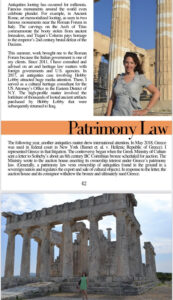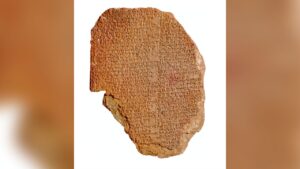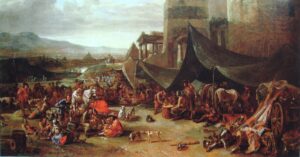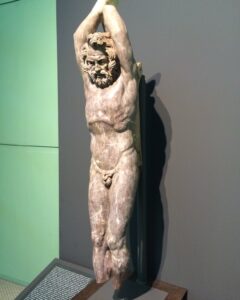by Amineddoleh & Associates LLC | Aug 22, 2021 |
Our founder was quoted in news outlets twice this week concerning art law matters. The first article addresses Poland’s new law concerning statutes of limitations and its effects on Nazi looted art claims. The second article discusses a disputed work at the Museum of Fine Arts in Houston that was allegedly sold under duress to the Nazi Party.
by Amineddoleh & Associates LLC | Aug 16, 2021 |
 Our founder has been featured in the Art She Says summer 2021 French Riviera Issue. Her contribution to the magazine discusses art theft, forgeries, government ownership of cultural heritage, World War II restitution matters, and artists’ rights, with a particular focus on the firm’s work and her experience as an art lawyer. This includes our firm’s recent representation of the Italian and GreekMinistries of Culture in federal court. These were landmark cases, sending the message that foreign sovereigns can continue to monitor the art market without fearing lawsuits when making inquiries as to potentially looted antiquities’ whereabouts. The article also touches on the forfeiture of antiquities from Hobby Lobby, since Leila served as a cultural heritage consultant for the U.S. Attorney’s Office in that matter, and another forfeiture case concerning a 13th century painting.
Our founder has been featured in the Art She Says summer 2021 French Riviera Issue. Her contribution to the magazine discusses art theft, forgeries, government ownership of cultural heritage, World War II restitution matters, and artists’ rights, with a particular focus on the firm’s work and her experience as an art lawyer. This includes our firm’s recent representation of the Italian and GreekMinistries of Culture in federal court. These were landmark cases, sending the message that foreign sovereigns can continue to monitor the art market without fearing lawsuits when making inquiries as to potentially looted antiquities’ whereabouts. The article also touches on the forfeiture of antiquities from Hobby Lobby, since Leila served as a cultural heritage consultant for the U.S. Attorney’s Office in that matter, and another forfeiture case concerning a 13th century painting.
Leila’s contribution concludes with an overview of due diligence and intellectual property rights, which are crucial for private collectors, particularly with the vast number of forgeries and stolen works on the market. The magazine also includes photographs taken by Leila. We invite you to visit the Art She Says website and read the issue to discover more about Leila’s contribution, as well as the other interesting and valuable articles in the publication. Art She Says is the leading digital magazine that empowers women in the art world through the curation of luxury content, networking events, and art advisory services.
An online copy of the article is available HERE.
by Amineddoleh & Associates LLC | Aug 6, 2021 |
On August 2, 2021, the Southern District of New York granted our motion to dismiss a case brought against the Republic of Italy. The case involved a marble bust (purportedly discovered in the Roman Forum) that was for sale by the Safani Gallery. We discussed the litigation and our motion to dismiss in a prior blog post. The highly anticipated opinion concerned the applicability of the Foreign Sovereign Immunities Act (FSIA) to the Republic of Italy; namely, whether Italy acted in such a manner that a U.S. court could obtain subject matter jurisdiction over it. The FSIA is the only means for US courts to obtain jurisdiction over foreign states, through a series of limited statutory exceptions. The court ruled that plaintiff Safani Gallery failed to establish grounds satisfying any of the exceptions named in its Amended Complaint. (The gallery initially alleged that Italy engaged in commercial activity, but then amended its complaint to instead allege waiver, expropriation, and tortious activity). In particular, the court noted that Italy did not engage in a taking in violation of international law, nor did it exert agency over the N.Y. law enforcement officials who seized the object in Manhattan. Judge Vernon Broderick noted that Italy’s communication with the District Attorney’s office was analogous to someone who reports a crime, which was insufficient to establish a fiduciary relationship. The seizure of the object was also carried out for a public purpose and was therefore lawful.
This case is the third in a line of litigations in which art market participants have sued foreign governments for communicating about problematic or suspicious antiquities. This is also the third case in that line of cases to be dismissed. The first of those litigations, Barnet et al. v. Ministry of Culture of the Hellenic Republic, involved an antiquity up for auction at Sotheby’s. Amineddoleh & Associates is proud to have represented Greece in the landmark case and to have secured a win for the nation. There, the Second Circuit Court of Appeals granted our motion to dismiss on behalf of Greece in June 2020. We are pleased that US courts have upheld foreign states’ defense from actions suing them for communicating with law enforcement or art market participants. Our firm is proud to have gained recognition as a leader in FSIA litigations and antiquities matters.
by Amineddoleh & Associates LLC | Jul 28, 2021 |

“Gilgamesh Dream Tablet” (Photo courtesy of US Department of Justice)
The epic saga of Gilgamesh continues as Hobby Lobby is once again caught in the crossfire of illicit antiquities trafficking. Yesterday, federal authorities forfeited a 3,500 year old clay cuneiform tablet known as the “Gilgamesh Dream Tablet” from the crafting giant. The tablet contains a portion of the “Epic of Gilgamesh” where the protagonist describes his dreams to his mother. It is considered a rare and ancient masterpiece of world literature.
The federal government had originally seized the tablet in 2019 and filed a civil forfeiture action in May 2020 to return it to Iraq. The tablet’s provenance was falsified to assert that it had been discovered in a box purchased at a California auction in 1981. In reality, the item had been purchased by an American dealer in London in 2003, who then brought it to the US. This timing coincided with widespread looting of archaeological sites in Iraq as a result of the ongoing war with the US. Hobby Lobby purchased the tablet for $1.6 million at a Christie’s auction in 2014, relying on the auction house to perform the appropriate due diligence. It transpired that the previous owner had warned Christie’s that the tablet’s stated provenance would not withstand scrutiny. The auction house failed to notify Hobby Lobby of this fact even after the craft company had expressed concerns. Ultimately, Hobby Lobby cooperated with the authorities and consented to the tablet’s forfeiture.
However, this is not Hobby Lobby’s first brush with the law over looted Middle Eastern antiquities. In 2010, representatives of Hobby Lobby purchased thousands of antiquities originating from Iraq for display at the future Museum of the Bible. The provenance information for the objects was fabricated, listing their origin as Israel or Turkey to avoid suspicions of illicit trafficking. Notably, Hobby Lobby consulted a respected cultural heritage expert regarding its acquisition, but went against her advice and continued with the transaction, ignoring several red flags indicating that the items had been looted. In 2017, a civil forfeiture action was filed and Hobby Lobby agreed to pay a $3.3 million fine and return over 5,500 looted objects to Iraq.
In this instance, our founder Leila Amineddoleh served as a cultural heritage law expert for the Eastern District of New York. She was extensively quoted on her participation in the matter in national media and trade outlets. She noted how the verdict resulted in greater public scrutiny over the purchase of antiquities and a higher expectation of due diligence measures related to provenance, even for so-called “inexperienced” purchasers. (Information about the matter can be found in our prior blog posts here and here.) This approach has indeed borne fruit, as the forfeiture of the Gilgamesh Dream Tablet demonstrates.
Law enforcement authorities in the US have been actively pursuing black market antiquities and disrupting trafficking networks for some time, but judicial enforcement and specialist support are also crucial. Many countries that suffer from cultural property looting and trafficking, including Iraq, have applicable provenance laws that cover items like the tablet. Furthermore, the US has placed import restrictions on Iraqi cultural property since 1990 and implemented sanctions as recently as 2010, allowing the government to seize objects at or after import. Judicial precedent has empowered US courts to recognize foreign patrimony laws and classify such objects as stolen property, increasing their protection on US soil, but government agents rely on knowledgeable attorneys and experts to advise them on cultural property protection and available legal remedies.
Amineddoleh & Associates LLC is proud to have a founder that has advised the government extensively on such matters and is a staunch advocate for responsible acquisition practices to combat the illicit antiquities trade. Our firm deals with various cases involving potentially looted items on behalf of private and public parties, and we are committed to ensuring that cultural property is protected irrespective of origin. Our strong track record in this field is a testament to our expertise and commitment to stemming the trade in looted objects. We commend the Department of Justice for its excellent work and look forward to continued collaboration in the future with law enforcement to ensure that looted antiquities return to their rightful homes.
by Amineddoleh & Associates LLC | Jul 23, 2021 |
 Amineddoleh & Associates LLC is pleased to contribute to the Preserving History Series by the American Institute for Roman Culture (AIRC). AIRC, founded in 2002, is a non-profit organization with locations in both the United States and Italy. The organization provides educational content, conducts archeological fieldwork, and provides its study abroad students with a full immersion into modern Italian culture while learning about the nation’s rich past. A lauded organization, AIRC has received numerous grants, including an NEH grant, American Express Foundation grant for the Villa delle Vignacce excavation, World Monuments Fund (WMF) collaboration for Santa Maria project, anonymous angel grants, and numerous donations from supporters. Its founder and director, Darius Arya, has received acclaim for his television and outreach work.
Amineddoleh & Associates LLC is pleased to contribute to the Preserving History Series by the American Institute for Roman Culture (AIRC). AIRC, founded in 2002, is a non-profit organization with locations in both the United States and Italy. The organization provides educational content, conducts archeological fieldwork, and provides its study abroad students with a full immersion into modern Italian culture while learning about the nation’s rich past. A lauded organization, AIRC has received numerous grants, including an NEH grant, American Express Foundation grant for the Villa delle Vignacce excavation, World Monuments Fund (WMF) collaboration for Santa Maria project, anonymous angel grants, and numerous donations from supporters. Its founder and director, Darius Arya, has received acclaim for his television and outreach work.

Flayed Marsyas at Centro Montemartini
One of the finds from the organization’s excavations can be viewed at Centrale Montemartini in Rome. In 2009, during a four-year excavation conducted by the Sovrintendenza Capitolina and AIRC, at Villa Vignacce in southeastern Rome, a statue in red marble was discovered. Dating from the 1st half of the 2nd century, it depicts the punishment of Marsyas. Marsyas was a satyr who challenged Apollo to a music contest. When Marsyas lost, Apollo had him tied to be flayed alive. In the Vignacce Marsyas, the bloodied skin is rendered by head, arms, torso and legs of a veiny red marble, while hands and feet would have been white marble. An extraordinary find, the statue is almost entirely intact, missing only one hand and both feet.
Amineddoleh & Associates LLC has a long history collaborating with AIRC, and we are pleased to contribute a series of post entries to the Preserving History Series.
 Our founder has been featured in the
Our founder has been featured in the 
 Amineddoleh & Associates LLC is pleased to contribute to the
Amineddoleh & Associates LLC is pleased to contribute to the 